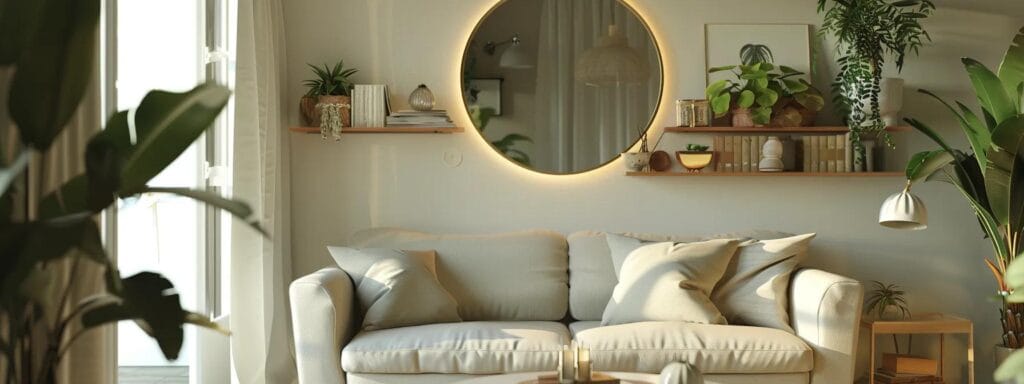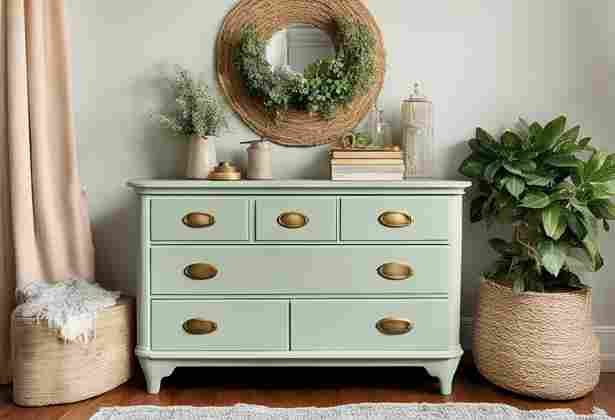Easy Ways to Decorate Small Spaces That Pop
Living in a small apartment or home doesn’t mean you have to settle for boring or cramped. In fact, the right design approach can turn even the tiniest corner into a statement space. If you’re wondering how to decorate small spaces in ways that are stylish, functional, and bold—this guide is for you!
1. Use Mirrors to Create the Illusion of Space
Mirrors reflect light and instantly make rooms feel larger. Hang a large mirror on a wall opposite a window or group smaller mirrors into a gallery wall. It’s one of the easiest ways to decorate small spaces and amplify natural light.
Why Mirrors Work
Mirrors act like windows. They bounce natural and artificial light around the room, making it feel brighter and more spacious. A well-placed mirror can visually double the size of a room or draw attention to focal points like plants or art.
Smart Mirror Placement Ideas
- Across From a Window
This is the gold standard. A mirror opposite a window reflects daylight and views, brightening the room and bringing the outdoors in. - Behind Furniture
Place a large mirror behind a sofa, console table, or bed to extend the visual depth of the room. - Hallways and Entryways
Narrow or dimly lit areas benefit hugely from a mirror. They add brightness and make tight spaces feel less confined. - On Closet or Cabinet Doors
Swapping solid doors for mirrored ones adds function without taking up wall space. - Above a Mantel or Shelf
Hang a mirror above a fireplace or floating shelf to add height and reflect decor elements.
Types of Mirrors That Suit Small Spaces
Not all mirrors serve the same purpose. Choose styles that enhance your layout without adding visual clutter:
- Frameless mirrors
These disappear into the wall, offering a seamless, modern look. Perfect for minimalist rooms or tight hallways. - Oversized floor mirrors
Lean one against a wall for instant drama and depth—no drilling required. They expand sightlines vertically and horizontally. - Grouped mirrors or mirror tiles
Use these to create a gallery wall effect. It’s affordable, customizable, and works well above sofas, beds, or dining tables. - Mirrored furniture
Think side tables, console tables, or even dressers. These reflect light subtly while blending with your decor. They boost space perception without crowding.
Each mirror style brings something unique—pick what matches your space, function, and taste.
Tips for Success
Mirrors can work magic—but only when used intentionally. Keep these guidelines in mind:
- Avoid facing clutter
Don’t place mirrors where they’ll reflect mess, cords, or visual chaos. You’ll double the distraction. - Reflect light, not noise
Aim mirrors toward natural light, lamps, or pendant fixtures. This brightens your space without adding extra objects. - Less is more
One large mirror or two smaller ones per room is plenty. Too many can feel overwhelming or disjointed. - Keep them clean
Dust and smudges block light and dull reflections. Wipe regularly for maximum effect.
Strategically placed mirrors should enhance your space—not compete with it.
Mirrors don’t just add style—they transform how a space feels and functions. For small homes, they’re a secret weapon for creating an airy, open vibe without knocking down walls.
2. Stick to Light, Bright Color Palettes
When decorating small spaces, color choice matters—a lot. Light tones make a room feel open, while darker shades can shrink it visually.
- Choose soft neutrals
Whites, off-whites, soft grays, and beige help walls recede, giving the illusion of more square footage. - Pastels can work magic
Hints of blush, powder blue, or mint green feel fresh without closing in the room. - Keep your large surfaces light
Walls, rugs, sofas, and curtains should stay within a light palette to maximize brightness. - Use color for contrast
Add depth with small pops of color—like throw pillows, a bold art piece, or an accent chair. - Balance is key
Aim for 80% light tones and 20% accents. This keeps the space grounded but not boring.
A light, cohesive palette opens up visual space—and gives you more freedom to swap accents seasonally.
3. Invest in Stylish Multi-Functional Furniture
In small spaces, every piece of furniture should earn its keep. Choose items that do double duty without crowding your room.
- A coffee table with hidden storage hides clutter out of sight.
- A sofa bed provides a place to sit and sleep for guests.
- A fold-out desk gives you workspace that disappears when not in use.
Look for slim, streamlined pieces with exposed legs. They keep the room feeling open and light. Tall bookshelves or modular sofas add flexibility and vertical storage.
Storage ottomans and benches with baskets add seating and hide stuff. Materials like glass or acrylic create an airy vibe without bulk.
Smart, flexible furniture supports your lifestyle and maximizes space—no compromise needed.
4. Go Vertical with Wall Storage and Art
Don’t let your walls go to waste—they’re prime real estate in small spaces.
- Install open shelves to store books, décor, or kitchen essentials.
- Hang plants to add life and texture without using floor space.
- Mount a floating desk or nightstand for a clean, modern look.
Use wall hooks or pegboards for coats, bags, or tools. Vertical storage draws the eye upward, making ceilings feel taller and rooms feel bigger.
Keep it neat. Too much clutter on walls can feel chaotic. Stick to essentials and arrange them with purpose.
A little elevation goes a long way in making a small room feel smart and spacious.
5. Use Lighting to Define Zones
In small homes or studios, lighting isn’t just for ambiance—it helps define space.
- Hang pendant lights over your dining nook to signal a mealtime zone.
- Add wall sconces near your sofa or bed for cozy reading corners.
- Use LED strip lights under shelves or cabinets for soft, modern glow.
Smart lighting placement creates boundaries without using walls or bulky furniture.
Stick to warm white tones (2700K–3000K) for a welcoming vibe. And if you can, go dimmable—it lets one fixture do more than one job.
Lighting can change how a room feels—so use it thoughtfully to create function and mood, even in the tightest layouts.
6. Opt for Statement Art (Yes, in Small Spaces!)
In small spaces, less really is more—but that doesn’t mean boring.
Choose one striking piece of wall art to anchor the room. Think oversized canvas, graphic prints, or a textured wall hanging.
It draws the eye, adds personality, and keeps the space feeling intentional—not cluttered.
Hang your art at eye level. Let it stand alone or pair it with minimal accents (like a slim lamp or small plant) to keep the focus clear.
A bold artwork says a lot—without taking up any floor space.
7. Add Life with Low-Maintenance Plants
Even in the smallest of spaces, plants can completely transform a room. They soften hard edges, bring color into neutral schemes, and make any area feel more vibrant and alive.
You don’t need a green thumb—or even much floor space—to add greenery.
Go vertical: Install a hanging planter by a window or use macramé plant holders. These create height without taking up square footage.
Shelf it: Add a few low-maintenance plants like succulents, pothos, or spider plants to your shelves, mantels, or floating ledges.
Choose the right varieties:
- Snake plants and ZZ plants are great for low light.
- Pothos are perfect for trailing down bookshelves or hanging planters.
- Peace lilies and rubber plants add lushness and help purify the air.
Tip: Use similar pots or planters in neutral tones for a cohesive look, or go bold with one statement plant in a colorful pot.
Remember: Even a single plant can change the mood of a space—adding warmth, movement, and a touch of nature to otherwise static corners.
8. Declutter Like a Pro (Then Add Texture)
In small spaces, visual clutter is the enemy of calm. The more streamlined your surfaces look, the more open your room feels. That doesn’t mean you need to go full minimalist—it means organizing with intention.
Start with storage:
- Use baskets or lidded boxes to hide loose items like cords, remotes, or papers.
- Tuck rolling bins or flat containers under the bed for seasonal clothes or linens.
- Opt for furniture with built-in storage—ottomans, benches, or coffee tables that lift open.
Once the clutter is under control, introduce texture to add warmth and depth without making the space feel crowded.
Try this:
- Layer throws over your sofa or bed in different weaves (like chunky knits or linen blends).
- Use area rugs to zone space and bring softness underfoot—great for rentals with cold floors.
- Incorporate woven materials like rattan, jute, or cane in baskets, trays, or wall art for natural contrast.
Texture makes a space feel lived-in—not overloaded. It’s the balance between tidy and cozy that gives small rooms personality without chaos.
✅ Final Tip: Less Is More
Decorating small spaces isn’t about limitation—it’s about intention. With the right mix of smart furniture, strategic lighting, and bold accents, even the tiniest home can feel open, vibrant, and uniquely yours. From clever storage to curated design choices, it’s all about maximizing what you have—not just physically, but emotionally. Every item, every color, every mirror has a job to do. So think big, even if your square footage isn’t—and let your space reflect your best self.
Frequently Asked Questions (FAQ)
🎯 Ready to Transform Your Space?
With a few smart design decisions, you can decorate small spaces in ways that feel open, inviting, and full of personality.
You don’t need more space—you just need better style.

Nick William is a dedicated travel blogger with a passion for uncovering hidden destinations and sharing authentic experiences from around the world. With a background in digital media and storytelling, he has developed a unique style that combines detailed research, vivid descriptions, and personal insights. His goal is to help readers not only plan their journeys but also connect with the culture, people, and stories behind each place.
When Nick isn’t exploring new cities or trekking off-the-beaten paths, he enjoys capturing moments through photography, reading history books, and sipping coffee while drafting his next adventure. His writing brings destinations to life, making every reader feel like a fellow traveler on the journey.


